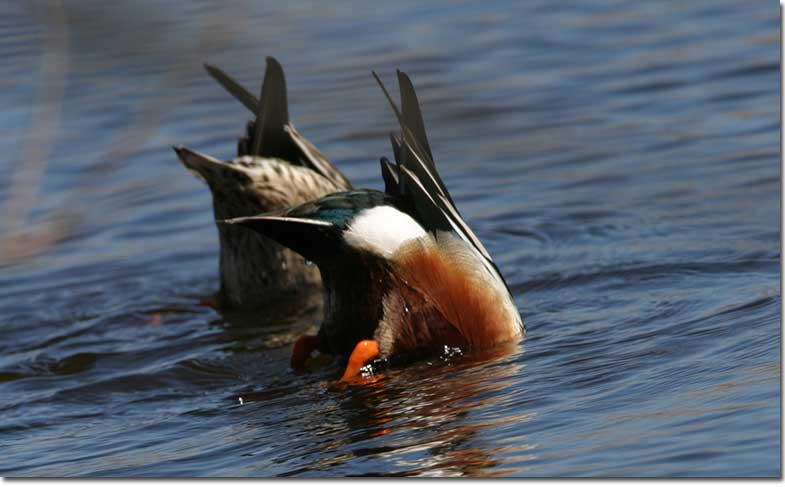
Ducks are such funny and beautiful birds! They paddle around ponds, some dive below the water, and many use their flat beaks to “nibble” the surface of the water.
Like most birds, ducks spend a lot time foraging for food. But what do they eat? What exactly do wild ducks eat? What about domestic ducks?
See this article to learn about duck diets, their favorite foods, and what you should never feed them.
On this page
The Diet of Ducks
Duck diets include all sorts of aquatic creatures as well as fish, mollusks, grain, and plant matter. However, not all ducks eat the same things. In general, we can categorize ducks into different groups, each of which have different diets, so the diets of male ducks and female ducks are not too different.
Mallards, Black Ducks, Gadwalls, and other ducks that forage while floating on shallow water are known as “dabbling ducks.” These types of ducks use their flat beaks to strain bits of plant matter and small bugs from the water.
Diving ducks like Lesser Scaups, Canvasbacks, and Common Goldeneyes eat a lot more mollusks and other small aquatic creatures. Scoters and eiders are also “divers” that forage for similar food items.
Some ducks also feed on fish, especially mergansers. These long-beaked ducks catch small fish after underwater chases!
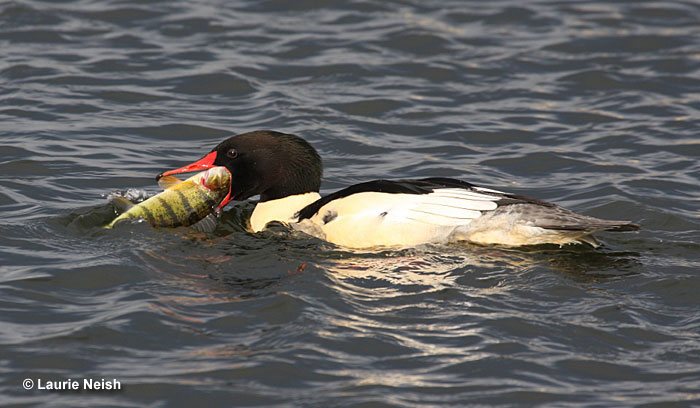
Common Merganser enjoying a meal
The final main type of the duck is the “grazer.” In North America, the American Wigeon is the main type of grazing duck. Although it also picks food from the surface of water, like a goose, this duck species likes to pick bits of grass and other plants from the ground.
Dabbling ducks, wigeons, and whistling-ducks also eat grain, especially during the winter. In cold months, seeds, rice, corn, and other types of grain are an important for thousands of ducks.
Invertebrates
Insects and other small aquatic invertebrates are essential food for many types of ducks. This food is especially important for Mallards, Northern Shovelers, and other dabblers. In summer, several diving ducks and young eiders also eat invertebrates, especially young birds.
Ducks eat midges and their larvae, as well as the larvae of other aquatic insects. They catch these small bugs by picking them from the surface and from right above the water.
Ducks also eat insects, snails, and other invertebrates by straining them from the water, and when those small creatures are attached to plant matter.
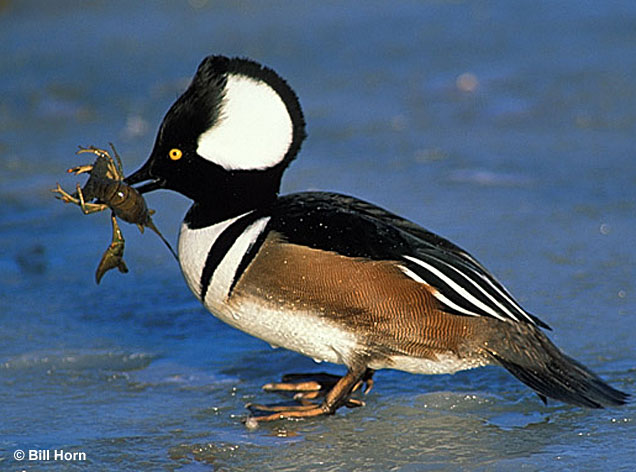
Hooded Merganser with a crab
They also catch tiny freshwater shrimp the same way, and can catch crayfish, clams and other crustaceans. When a duck catches a crayfish, it keeps biting the small animal until it crushes enough of its shell to eat it.
Canvasbacks and other diving ducks forage for mollusks by diving, picking them from structures, rocks, or mud, and then usually crushing and swallowing them whole.
Amphibians
Ducks don’t eat amphibians as much as other types of food.
Compared to hawks and herons, waterfowl aren’t very adapted to catching and feeding on frogs and salamanders. However, since most ducks are opportunistic omnivores, once in a while, some species catch them.
Duck species like Mallards, Wood Ducks, and American Black Ducks can eat the occasional frog, but mostly small frogs and probably only when they lack other types of food. In all likelihood, these ducks also typically eat small frogs when the opportunity presents itself (like when a frog is injured).
As far as amphibians go, ducks are much more likely to eat tadpoles. If they think they can catch them, many duck species will eat tadpoles. Several also eat the occasional salamander but not as often as other types of food.
Hooded Mergansers tend to eat more frogs and amphibians than other duck species, but even this small duck prefers fish and small crustaceans.
Plant material
Plants play an important role in the diets of many duck species, especially during colder months. Mallards, teals, and other dabbling ducks feed on different types of duckweeds other aquatic plants, and some tubers. They pick these plant items from the surface and beneath the water, and also pick up seeds from the ground.
In winter, these species, American Wigeons, and some other ducks also feed on acorns, seeds, and grain. They usually forage for these food items by visiting farm fields and using their beaks to pick up corn, barley, wheat, and other types of grain.
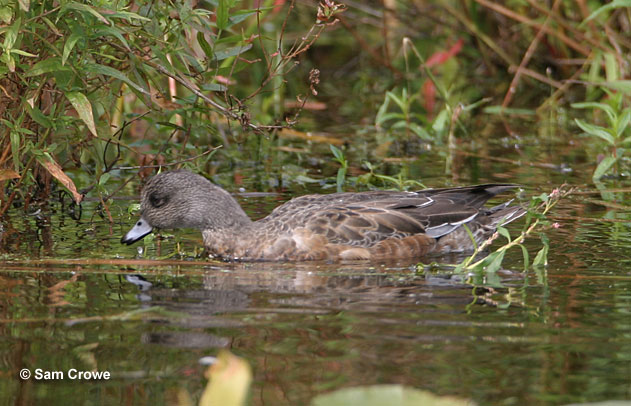
For Wigeons, plant matter makes up a large part of their diet
Wigeons, Mallards, and other species also forage for plant shoots and such plants as clover and potato leaves. They feed on these and some other plants by walking on the ground and nipping leaves and other bits of plant matter.
Ducks also love to eat wild celery, milfoil, watercress, wigeon grass, spinach, peas, parsley, and other plants that people also eat.
What Do Ducklings Eat?
Unlike small birds and many other bird species, baby ducks feed themselves. Although mother ducks lead their ducklings to good feeding areas, they don’t give them any food. Shortly after a Mallard or other duck species hatches, it leaves the egg, follows its mother, and starts feeding right away.
Given their small size, it’s no surprise that ducklings eat small food items.
They catch and eat lots of small insects, worms, and most other small creatures that they happen to see. Ducklings forage by picking these food items from the ground as well as from the surface of water.
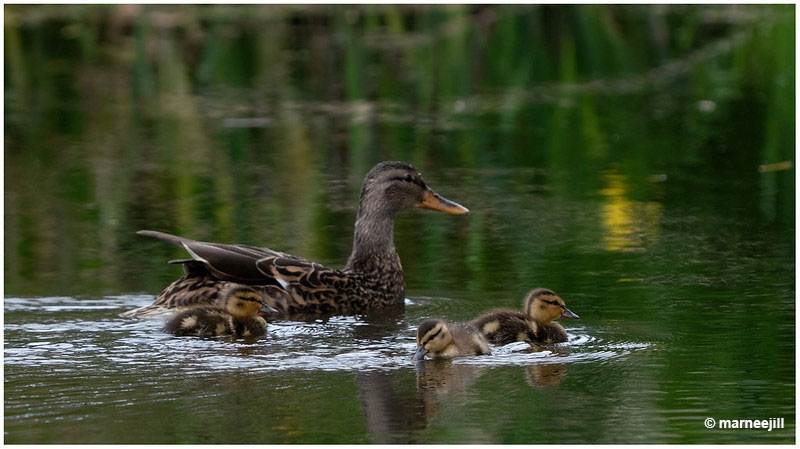
© marneejill
While staying near their mother, they follow their instincts and watch for any possible food item. If they see a bug, small worm, seed, or other items that look like possible food, the baby duck reaches down to grab it with its beak.
Although they feed by following their instincts, trying all sorts of food might also help baby ducks learn what tastes better and the types of foods to avoid. At first, most of their food includes insects and other small animals. This high-protein diet is necessary for quick growth, but as they get older, ducklings also eat more seeds and plants.
What To Feed Wild Ducks?
Wild ducks find plenty of their own food. However, just like birds at backyard feeders, some wild ducks can also learn to take food from people. Maybe not from your hand, but they’re happy to pick up food at the edge of urban ponds and lakes!
Feeding ducks is popular, especially feeding them leftover bread. It’s easy to do, but although ducks love it, unfortunately, bread is a bad choice. This processed food is like junk food for ducks and only gives them empty calories. Bread can also be bad for them when it becomes soggy and contaminated with fungus and bacteria.
Instead of feeding ducks bread, try these nutritious, more natural items:
- Instants oats and cracked corn – Ducks love eating oats and other grain, it’s also good for them.
- Seeds – Ducks like birdseed, too!
- Peas and lettuce – Just make sure the peas aren’t seasoned with anything.
- Duck pellets – This food is developed for ducks.
Domesticated Ducks
Domesticated ducks can eat many of the same foods as wild ducks. However, since they live in a much more controlled environment, farm and pet ducks don’t have access to nearly as much wild food. Most of their diet consists of commercial duck or chicken feed pellets.
When outside, they can eat bugs and worms and could eat some plants but far fewer native plants than wild ducks eat. However, if they forage in a big garden or on a farm, domesticated birds can eat lots of bugs, slugs, snails, worms, and other small creatures.
With that in mind, free-ranging domesticated ducks can help rid the garden of pests. The only problem is that they also love to eat lettuce and other garden greens!
Both wild and domestic ducks also feed on lots of grain. Wild ducks routinely forage for barley, oats, and various other types of grain, especially in the winter. In fact, in many places, such grain and seeds probably help duck populations survive the winter months. They also need grit to be able to grind food.
Domesticated ducks can also be fed cracked corn, occasional snacks of cooked rice, sliced pumpkin, different veggies (such as broccoli, cabbage, cauliflower, and carrots), beans, and fruits like grapes, berries, and watermelon. However, these “treats” should only make up ten percent of their overall diet, so they could get all the necessary vitamins and minerals from their diets.
The Diet of Ducks: FAQ’s
Do ducks need to eat everyday?
Yes, ducks need to eat everyday. Domesticated ducks should be fed twice per day.
What do ducks eat most?
Ducks mostly eat small bugs and other small aquatic creatures, aquatic plants, grains, seeds, and leafy plants.
How often do ducks eat?
Ducks eat several times a day. However, if they have a good food source, they only need to eat twice per day.
Do ducks eat small fish?
Yes, several types of ducks eat small fish.
What foods can ducks not eat?
Ducks can not eat bread, chocolate, citrus fruits, avocados, onions, popcorns, junk food, and moldy or old food. None of these foods are good for ducks and some can harm them.

